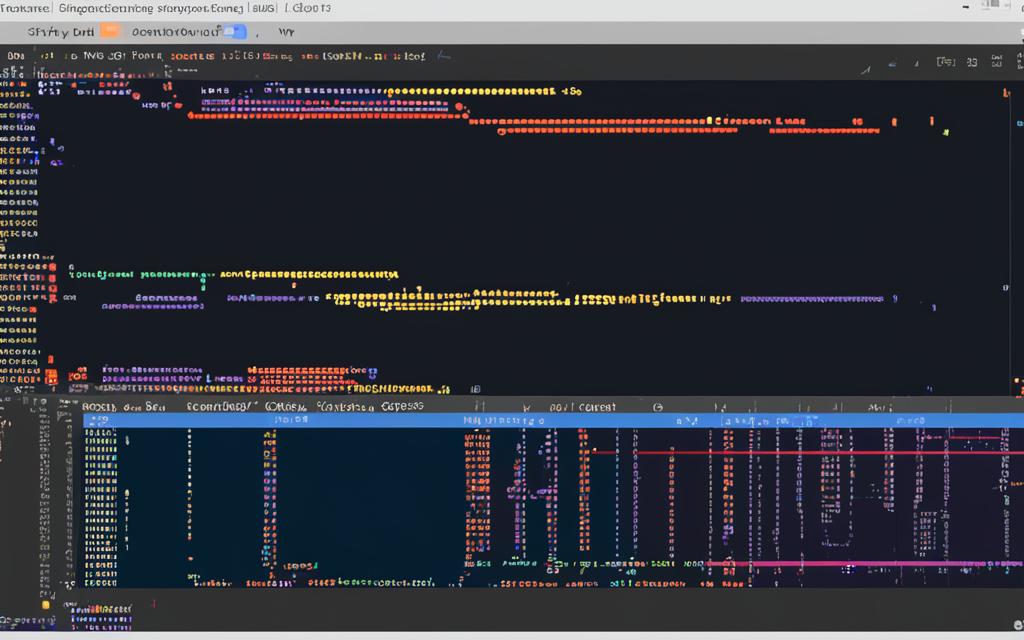As a seasoned programmer, I’ve long been fascinated by the incredible capabilities of Python. This versatile language has become a powerhouse in the world of software development, offering a wealth of tools and libraries that can unlock new realms of possibility. But have you ever wondered just how far the reach of Python extends? From machine learning to data science, artificial intelligence to natural language processing, the applications of this dynamic language are truly limitless.
In this comprehensive guide, I’ll take you on a journey through the diverse and ever-evolving landscape of Python. We’ll explore how this powerful programming language can be leveraged to transform data into insights, automate complex processes, and even push the boundaries of human-computer interaction. Whether you’re a seasoned coder or just starting your programming journey, this article will equip you with the knowledge and inspiration to harness the full potential of Python.
But first, let me pose a question that I hope will pique your curiosity: What if I told you that Python could unlock the secrets of the universe, one line of code at a time? Intrigued? Well, you’ll just have to keep reading to find out how this unassuming language can become your gateway to the extraordinary.
Introducing Python: The Versatile Programming Language
Python is a powerful and versatile programming language that has gained immense popularity over the years. As a high-level, general-purpose language, python with its simplicity, readability, and flexibility has made it a preferred choice for a wide range of applications, from web development and data analysis to machine learning and scientific computing.
What is Python?
Python was created in the late 1980s by Guido van Rossum, a Dutch programmer who sought to develop a language that was easy to read and write. Since then, the python programming language has evolved into one of the most widely used programming languages in the world, known for its clean syntax, intuitive design, and extensive standard library.
Why Choose Python?
There are several reasons why the python programming language has become so popular:
- Simplicity and Readability: Python’s syntax is straightforward and easy to understand, making it an excellent choice for beginners and experienced programmers alike.
- Versatility: Python with its versatility allows it to be used in a wide range of applications, from web development and scientific computing to machine learning and data analysis.
- Large Standard Library: Python comes with a vast standard library that provides a wealth of pre-built functionality, allowing developers to quickly build complex applications without having to reinvent the wheel.
- Cross-Platform Compatibility: Python is a cross-platform language, meaning it can run on various operating systems, including Windows, macOS, and Linux, making it a popular choice for developers working on different platforms.
- Active Community: Python has a thriving and active community of developers who contribute to its growth, create new libraries and tools, and provide support and resources for users.
Whether you’re a beginner or an experienced programmer, the python programming language offers a wealth of opportunities to explore and master. Its versatility, simplicity, and strong community support make it an increasingly popular choice for a wide range of applications.
Python with Machine Learning: Unleashing Artificial Intelligence
As the field of artificial intelligence continues to evolve, machine learning has emerged as a powerful tool for building intelligent systems and applications. Python, with its extensive ecosystem of powerful libraries and frameworks, has become a leading language for machine learning. In this section, we’ll delve into the fundamentals of machine learning and explore the Python tools that make it possible to unlock the full potential of artificial intelligence.
Machine Learning Fundamentals
At its core, machine learning is the process of training computers to learn and improve from experience without being explicitly programmed. This involves feeding data into algorithms that can identify patterns, make predictions, and make decisions without relying on rule-based programming. Python with machine learning enables us to leverage these powerful techniques to build intelligent systems that can adapt and evolve over time.
Python Libraries for Machine Learning
Python’s versatility and ease of use have made it a popular choice for machine learning projects. The language boasts a rich collection of machine learning fundamentals libraries, each offering unique capabilities and features. Some of the most widely used Python libraries for machine learning include:
- TensorFlow, a powerful open-source library developed by Google for building and deploying machine learning models.
- Scikit-learn, a robust and user-friendly library for implementing a wide range of machine learning algorithms.
- PyTorch, a flexible and dynamic library for building and training deep learning models.
- Keras, a high-level neural networks API that runs on top of TensorFlow, making it easy to build and train complex models.
These python libraries for machine learning provide a comprehensive set of tools and functions, allowing developers to quickly prototype, train, and deploy machine learning models, unlocking the full potential of artificial intelligence with Python.
Python with Data Science: Unraveling Insights from Raw Data
As a data science enthusiast, I’ve found that Python has become a powerful ally in my quest to extract meaningful insights from complex data sets. The seamless integration of python with data science has opened up a world of possibilities, allowing me to navigate the data science workflow with ease.
At the heart of this synergy lies Python’s robust and versatile ecosystem of libraries. From data manipulation and cleaning with pandas to advanced statistical analysis with NumPy and SciPy, Python provides a comprehensive toolkit for the entire data science lifecycle.
One of the standout features of data science with python is its ability to handle a wide range of data formats, from structured databases to unstructured text and multimedia. By leveraging libraries like Matplotlib and Seaborn, I can bring these data sets to life through captivating visualizations, empowering me to uncover hidden patterns and trends.
Moreover, the integration of machine learning algorithms through libraries such as scikit-learn and TensorFlow has revolutionized the way I approach data-driven decision making. With Python, I can seamlessly build, train, and deploy predictive models, unlocking a new era of data-driven insights.
As I continue to explore the depths of python with data science, I’m constantly amazed by the versatility and power of this dynamic duo. From data extraction and preprocessing to advanced analytics and model deployment, Python has become an indispensable tool in my data science arsenal, enabling me to unravel the complexities of raw data and transform it into actionable knowledge.

In the ever-evolving landscape of data science, python with data science remains a formidable force, empowering individuals like myself to unlock the true potential of data and drive meaningful change. Whether you’re a seasoned data scientist or just starting your journey, I encourage you to embrace the power of this dynamic partnership and embark on a fulfilling exploration of the data-driven world.
Python with Deep Learning: Exploring Neural Networks
In the realm of machine learning, deep learning has emerged as a powerful technique that has revolutionized the way we approach complex problems. As a subfield of machine learning, deep learning focuses on building and training artificial neural networks to learn and make predictions from large-scale data. Python has become the language of choice for deep learning enthusiasts, thanks to its user-friendly syntax, extensive libraries, and robust community support.
Deep Learning Architectures
Deep learning architectures are the backbone of this powerful technology. These intricate neural network structures, inspired by the human brain, are designed to process and extract meaningful insights from vast amounts of data. From convolutional neural networks (CNNs) for image recognition to recurrent neural networks (RNNs) for natural language processing, the versatility of deep learning architectures is truly remarkable.
Python Frameworks for Deep Learning
The Python ecosystem offers a wide array of frameworks that make it easier to harness the power of python with deep learning. Prominent frameworks like TensorFlow, Keras, and PyTorch provide developers with the tools they need to build, train, and deploy deep learning architectures with ease. These python frameworks for deep learning abstract the complex underlying mathematics, allowing practitioners to focus on the high-level design and implementation of their deep learning models.
Whether you’re a seasoned machine learning enthusiast or a curious beginner, exploring the realm of python with deep learning can open up a world of possibilities. By leveraging the power of neural networks and the flexibility of Python, you can unlock new frontiers in artificial intelligence and push the boundaries of what’s possible.
Python with Natural Language Processing: Bridging the Human-Computer Gap
As an avid programmer, I’ve always been fascinated by the intersection of natural language processing (NLP) and the powerful programming language, Python. NLP is a field of artificial intelligence that empowers computers to understand, interpret, and even generate human language. And Python, with its robust libraries like NLTK, spaCy, and TextBlob, has emerged as a go-to choice for NLP enthusiasts like myself.
In this section, we’ll delve into the exciting world of python with natural language processing and explore how this dynamic duo can be harnessed to tackle a wide range of NLP tasks, from text classification and sentiment analysis to language translation and chatbot development.
Mastering Text Classification and Sentiment Analysis
One of the core capabilities of natural language processing with python is the ability to classify text and analyze sentiment. Using Python’s NLP libraries, we can train models to categorize documents, emails, or social media posts into predefined classes, such as positive, negative, or neutral. This powerful tool can be leveraged in a variety of applications, from customer service to content moderation.
Revolutionizing Language Translation and Chatbot Development
But the capabilities of Python and NLP don’t stop there. We can also utilize these technologies to break down language barriers and facilitate seamless communication. Python’s NLP libraries can be used to develop advanced language translation systems, allowing users to converse in their native tongues while the computer handles the translation. Furthermore, these tools can be employed in the creation of intelligent chatbots, capable of engaging in natural dialogues and providing personalized assistance to users.
As you can see, the synergy between python with natural language processing is truly remarkable, opening up a world of possibilities for developers and users alike. Whether you’re looking to automate language-based tasks, gain insights from unstructured data, or push the boundaries of human-computer interaction, Python and NLP are a dynamic duo worth exploring.
Python with Artificial Intelligence: Automating Intelligence
Artificial Intelligence (AI) is the field of study that focuses on empowering computers to perform tasks typically requiring human intelligence, such as decision-making, problem-solving, and pattern recognition. Python has become a popular language for AI, with its extensive libraries and frameworks like scikit-learn, PyTorch, and TensorFlow making it easier to build and deploy intelligent systems.
AI Algorithms in Python
Python offers a vast array of AI algorithms that can be leveraged to develop intelligent applications. From classic machine learning techniques like regression, classification, and clustering to the latest advancements in deep learning, Python provides the tools to implement a wide range of AI algorithms. Utilizing libraries like scikit-learn and TensorFlow, developers can seamlessly integrate AI algorithms into their Python-based projects, automating tasks and unlocking new possibilities.
Building Intelligent Systems with Python
Crafting end-to-end AI applications with Python involves more than just implementing algorithms. It requires a comprehensive understanding of the entire development lifecycle, from data preprocessing and feature engineering to model training, deployment, and maintenance. Python’s robust ecosystem of frameworks and tools, such as Pandas and NumPy for data manipulation, and Flask or Django for web-based AI applications, empowers developers to build intelligent systems that can adapt and evolve with the changing needs of the modern world.
By harnessing the power of python with artificial intelligence, developers can automate complex tasks, unlock valuable insights from data, and create innovative solutions that push the boundaries of what’s possible. Whether you’re exploring ai algorithms in python or building intelligent systems with python, Python’s versatility and extensive AI capabilities make it a premier choice for driving the next generation of intelligent applications.

Python with Data Analysis: Transforming Data into Knowledge
As a powerful programming language, Python has become a go-to tool for data analysis. By leveraging its extensive libraries and robust features, we can unlock the true potential of raw data and transform it into valuable insights and knowledge. In this section, we’ll delve into the key aspects of data analysis using Python, exploring the critical steps of data cleaning, preprocessing, and statistical analysis.
Data Cleaning and Preprocessing
Data analysis begins with ensuring the quality and integrity of the data. Python with data analysis provides us with a range of tools and techniques to clean and preprocess our data. From handling missing values to removing duplicates and addressing data inconsistencies, Python’s data manipulation libraries, such as Pandas, make the process seamless and efficient.
Statistical Analysis with Python
Once the data is clean and preprocessed, we can dive into the realm of statistical analysis. Python with data analysis offers a wealth of statistical libraries, including NumPy and SciPy, which enable us to perform a wide range of statistical tests, regression analysis, and data modeling. By leveraging these powerful tools, we can uncover patterns, trends, and meaningful relationships within our data, ultimately transforming it into actionable knowledge.
| Python Library | Key Features for Data Analysis |
|---|---|
| Pandas | Data manipulation, cleaning, and preprocessing |
| NumPy | Numerical computing, statistical analysis, and linear algebra |
| SciPy | Scientific and technical computing, including optimization, linear algebra, and statistics |
By mastering Python with data analysis, we can unlock powerful insights, uncover hidden patterns, and drive informed decision-making across various industries and domains. Whether you’re a data scientist, analyst, or a professional seeking to leverage the power of data, Python’s data analysis capabilities are sure to leave a lasting impact on your work.
Python with Data Visualization: Bringing Data to Life
As a data enthusiast, I’ve discovered the power of data visualization in bringing complex information to life. Python, with its rich ecosystem of data visualization libraries, has become an indispensable tool in my toolkit. From creating stunning charts and graphs to developing interactive visualizations, Python’s versatility in the realm of data visualization is truly remarkable.
Data Visualization Libraries
When it comes to data visualization in Python, there are several popular and powerful libraries to choose from. Matplotlib, one of the most widely used libraries, offers a wide range of plotting options, from simple line plots to more complex heatmaps and scatter plots. Seaborn, on the other hand, is known for its ability to create visually appealing and informative statistical graphics. For those seeking to create more interactive and web-based visualizations, Plotly is a go-to choice, allowing users to build dynamic dashboards and data exploration tools.
Creating Interactive Visualizations
- One of the key advantages of using Python for data visualization is its ability to create interactive visualizations. These visualizations allow users to explore data, filter information, and gain deeper insights through dynamic interactions.
- Using libraries like Plotly and Bokeh, I can easily build interactive plots, charts, and dashboards that engage the audience and facilitate data-driven decision-making.
- From creating interactive line charts that respond to user input to building complex, multi-dimensional visualizations, Python’s data visualization capabilities empower me to bring my data to life in ways that captivate and inform my audience.
Whether you’re a data scientist, a business analyst, or simply someone who wants to tell a compelling data-driven story, Python’s data visualization tools are an invaluable asset. By harnessing the power of python with data visualization, you can unlock the true potential of your data and create interactive visualizations with python that leave a lasting impact.
python with: Powerful Tools for Diverse Applications
As a versatile programming language, Python has found its way into a wide array of industries and applications. From web development and automation to data science and artificial intelligence, the versatile applications of python continue to impress developers and professionals alike.
One of the key strengths of Python is its extensive and ever-growing ecosystem of libraries and frameworks. These powerful tools enable developers to tackle complex tasks with ease, streamlining the development process and boosting productivity.
For web development, Python offers frameworks like Django and Flask, which simplify the creation of dynamic and responsive websites. Automation enthusiasts can leverage Python to build scripts that tackle repetitive tasks, saving time and reducing the potential for human error.
In the realm of data science, Python shines with libraries such as NumPy, Pandas, and Matplotlib. These tools empower users to wrangle, analyze, and visualize data with remarkable efficiency, unlocking valuable insights from raw information.
The rise of artificial intelligence and machine learning has further solidified Python‘s position as a go-to language. Frameworks like TensorFlow, Keras, and PyTorch enable developers to build and deploy sophisticated machine learning and deep learning models with ease.
Beyond these mainstream applications, Python also finds use in scientific computing, game development, natural language processing, and even Internet of Things (IoT) projects. Its versatility and accessibility make it a favorite among developers, scientists, and aspiring coders alike.
Ultimately, the versatile applications of python underline its status as a powerful and adaptable programming language. Whether you’re a seasoned professional or a budding coder, Python offers a diverse toolkit to tackle a wide range of challenges and bring your ideas to life.

Mastering Python: Tips and Best Practices
Becoming a proficient Python programmer requires more than just understanding the language’s syntax and features. It’s equally important to adopt best practices and techniques for writing clean, maintainable, and efficient code. In this section, we’ll delve into the world of Python coding conventions, including the renowned PEP 8 guidelines, and explore effective strategies for debugging and testing your Python applications.
Python Coding Conventions
Adhering to mastering python coding conventions is crucial for ensuring that your codebase is consistent, readable, and easy to maintain. The Python community has established the PEP 8 (Python Enhancement Proposal 8) standard, which outlines a set of guidelines and recommendations for writing Python code. By following these conventions, you can create code that is not only visually appealing but also more understandable to other developers, including your future self.
- Consistent code formatting, such as indentation, variable naming, and function/class naming
- Appropriate use of whitespace to enhance readability
- Docstrings and comments to explain the purpose and functionality of your code
- Consistent error handling and exception management
Debugging and Testing in Python
Regardless of your python coding conventions, no application is perfect, and bugs are bound to arise. Fortunately, Python provides a range of tools and strategies to help you identify and resolve issues during the development process. Debugging and testing in python is an essential skill for ensuring the reliability and robustness of your Python applications.
- Leveraging the built-in
print()statements and the Python debugger (pdb) to step through your code and identify the root cause of problems - Implementing unit tests to validate the functionality of individual components of your application
- Utilizing code coverage tools to ensure that your test suite is comprehensive and effective
- Automating your testing process with continuous integration (CI) tools for early detection of regressions
By mastering python coding conventions and developing effective debugging and testing in python practices, you’ll be well on your way to becoming a true Python expert, capable of writing clean, maintainable, and high-quality code.
Python in the Real World: Success Stories and Use Cases
As a versatile and powerful programming language, Python has gained widespread adoption across various industries and sectors, from academia and scientific research to business and enterprise applications. In this section, we’ll explore real-world success stories and use cases that showcase the impact of Python in the professional world.
Python in Academia and Research
Python has become a go-to language for researchers and academics working in diverse fields. Its robust scientific computing libraries, such as NumPy, SciPy, and Pandas, have made it a preferred choice for data analysis, modeling, and visualization tasks. In the realm of python in academia and research, Python has been instrumental in advancing fields like computational biology, climate science, and material science, where it has enabled researchers to efficiently process and interpret complex data sets.
Python in Industry and Business
The adoption of python in the real world has also been remarkable in the corporate landscape. Python’s versatility and ease of use have made it a go-to language for developing a wide range of business applications, from e-commerce platforms and financial modeling tools to data-driven decision-making systems. In the python in industry and business domain, companies across various sectors, including finance, healthcare, and technology, have leveraged Python’s capabilities to streamline their operations, automate processes, and gain valuable insights from data.
| Industry | Python Use Case |
|---|---|
| Finance | Quantitative analysis, trading algorithms, risk management |
| Healthcare | Medical image analysis, drug discovery, patient data management |
| E-commerce | Recommendation systems, web scraping, data analytics |
The success stories and use cases of Python in the real world, from academia and research to industry and business, showcase the language’s versatility, scalability, and ability to drive innovation across diverse domains.
Python Community and Resources: Staying Up-to-Date
As a Python enthusiast, staying connected with the vibrant Python community is crucial for your growth and development. The Python ecosystem is home to a wealth of online resources, communities, and events that can help you learn, collaborate, and contribute to the evolution of this versatile programming language.
Online Communities and Forums
One of the best ways to engage with the Python community is by participating in online forums and communities. These platforms provide a space for Python developers, enthusiasts, and learners to share their knowledge, ask questions, and discuss the latest trends and best practices. Some of the most active and influential Python communities include:
- Python subreddit – A thriving online community on Reddit with over 1 million subscribers, covering a wide range of Python-related topics.
- Stack Overflow Python tag – A popular question-and-answer platform where Python developers can seek help, share insights, and collaborate on projects.
- Python Discord server – A vibrant and well-moderated Discord server where Python enthusiasts connect, chat, and learn from each other.
Python Conferences and Meetups
In addition to online communities, the Python community organizes numerous conferences and meetups around the world, providing opportunities for face-to-face networking, learning, and professional development. Some of the most notable Python events include:
- PyCon – The largest annual gathering of the global Python community, featuring workshops, talks, and networking events.
- PyData – A series of conferences and workshops focused on the intersection of Python and data science, machine learning, and artificial intelligence.
- Local Python Meetup Groups – Grassroots communities that organize regular meetups, workshops, and discussions on various Python-related topics.
By engaging with the Python community, both online and in person, you can stay up-to-date with the latest trends, learn from experienced developers, and contribute to the ongoing growth and development of the Python ecosystem.
Python for Beginners: Getting Started with Coding
Eager to dive into the world of programming? Python, a versatile and beginner-friendly language, is the perfect place to start. Whether you’re a complete coding novice or looking to expand your skills, this section will guide you through the process of setting up your Python environment and writing your first Python program.
Setting Up Your Python Environment
The first step in your Python journey is to ensure you have the necessary software installed. Python is available for free on the [https://omavtech.com/advanced-topics-mastering-complex-concepts/] official website, and the installation process is straightforward. Once you’ve downloaded and installed Python, you’ll need to configure your development environment, which could involve choosing a code editor or setting up a virtual environment.
Writing Your First Python Program
- Open your preferred code editor and create a new file.
- Start by writing a simple “Hello, World!” program to familiarize yourself with Python’s syntax.
- Explore basic data types, such as integers, floats, and strings, and learn how to perform basic operations with them.
- Dive into control structures, like if-else statements and for loops, to add logic and decision-making to your programs.
- Practice writing functions to modularize your code and make it more reusable.
By the end of this section, you’ll have the confidence and skills to start writing your own python programs and explore more advanced topics in the world of python for beginners, setting up python environment, and writing first python program.
| Task | Description |
|---|---|
| Install Python | Download and install the latest version of Python from the official website. |
| Choose a Code Editor | Select a code editor like Visual Studio Code, PyCharm, or Sublime Text to write your Python code. |
| Write “Hello, World!” | Create a new Python file and write a simple “Hello, World!” program to get started. |
| Explore Data Types | Learn about the different data types in Python, such as integers, floats, and strings. |
| Understand Control Structures | Familiarize yourself with conditional statements and loops to add logic to your programs. |
Conclusion
As we conclude our exploration of the python programming language, I hope you’ve gained a deeper appreciation for its versatility and the wealth of possibilities it offers. From machine learning and data science to artificial intelligence and data visualization, python has emerged as a powerhouse in the world of technology, empowering professionals and enthusiasts alike to tackle complex challenges with efficiency and creativity.
Throughout this guide, we’ve delved into the core fundamentals of python, uncovering its intuitive syntax, robust libraries, and the vibrant community that supports its ongoing development. Whether you’re a seasoned programmer or just starting your coding journey, python’s adaptability and extensive ecosystem of tools make it an invaluable asset in your arsenal.
As you continue your python journey, remember to stay curious, embrace the power of collaboration, and never stop learning. The python programming language is a constantly evolving landscape, and by staying informed and engaged, you’ll be well-equipped to harness its potential and drive innovation in your field. Embrace the endless possibilities that python with offers, and let your creativity soar.
FAQ
What is Python?
Python is a high-level, general-purpose programming language known for its simplicity, readability, and flexibility. It was created in the late 1980s by Guido van Rossum and has since become one of the most widely used programming languages in the world.
Why should I choose Python?
Python’s versatility and ease of use have made it a popular choice for a wide range of applications, from web development and data analysis to machine learning and scientific computing. It has an extensive ecosystem of powerful libraries and frameworks that make it a great choice for beginners and experienced programmers alike.
How can I use Python for machine learning?
Python has emerged as a leading language for machine learning, thanks to its extensive ecosystem of powerful libraries and frameworks, such as TensorFlow, Scikit-learn, and PyTorch. These tools make it easier to build and train intelligent systems and applications.
What can I do with Python in the field of data science?
Python has become a go-to language for data scientists, thanks to its robust libraries for data manipulation, analysis, and visualization. You can use Python for the entire data science workflow, from data collection and cleaning to statistical analysis and model building.
How can I use Python for deep learning?
Python has become a popular choice for deep learning, with frameworks like TensorFlow, Keras, and PyTorch providing powerful tools for building, training, and deploying deep learning models. These frameworks make it easier to harness the power of neural networks and explore the field of deep learning.
What can I do with Python in the field of natural language processing?
Python has become a go-to language for natural language processing (NLP), thanks to its robust libraries like NLTK, spaCy, and TextBlob. You can use Python for a wide range of NLP tasks, from text classification and sentiment analysis to language translation and chatbot development.
How can I use Python for artificial intelligence?
Python has become a popular language for AI, with its extensive libraries and frameworks like scikit-learn, PyTorch, and TensorFlow making it easier to build and deploy intelligent systems. You can use Python to implement various AI algorithms and techniques, as well as to build end-to-end AI applications.
How can I use Python for data analysis and visualization?
Python has a rich ecosystem of data analysis and visualization libraries, including Matplotlib, Seaborn, and Plotly, that make it easy to clean, preprocess, and analyze data, as well as create stunning visualizations to help you understand and interpret complex information.
Where can I find resources and communities to help me master Python?
The Python community is vast and vibrant, with a wealth of online resources, communities, and events that can help you stay up-to-date with the latest trends, best practices, and innovations in the Python ecosystem. You can connect with other Python enthusiasts, learn from experienced developers, and contribute to the growth and development of the Python language.
How do I get started with Python as a beginner?
If you’re new to programming or just getting started with Python, we’ll guide you through the process of setting up your Python environment and writing your first Python program. You’ll learn the basic syntax, data types, and control structures that form the foundation of the language, giving you the confidence and skills to start writing your own Python scripts and applications.























